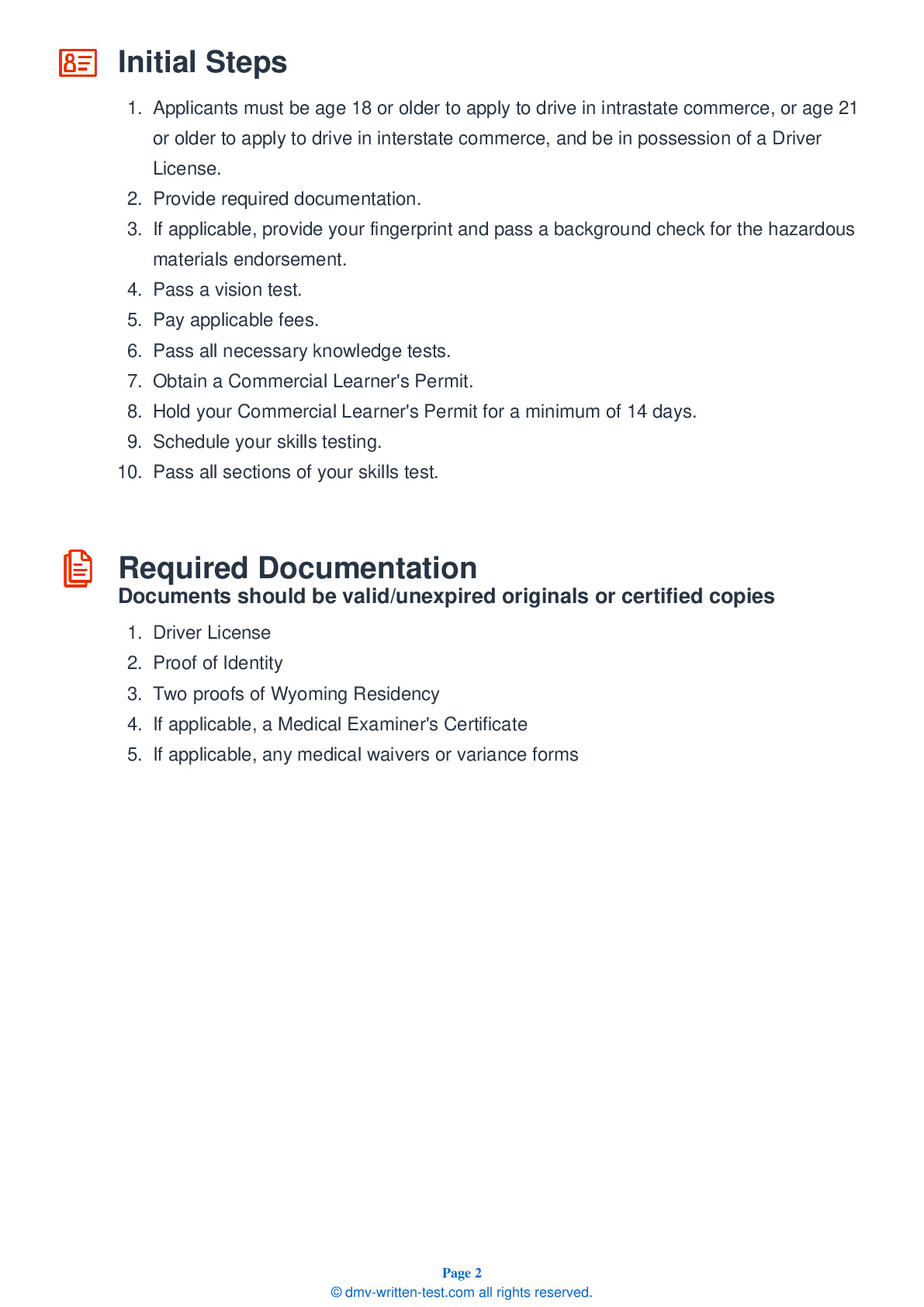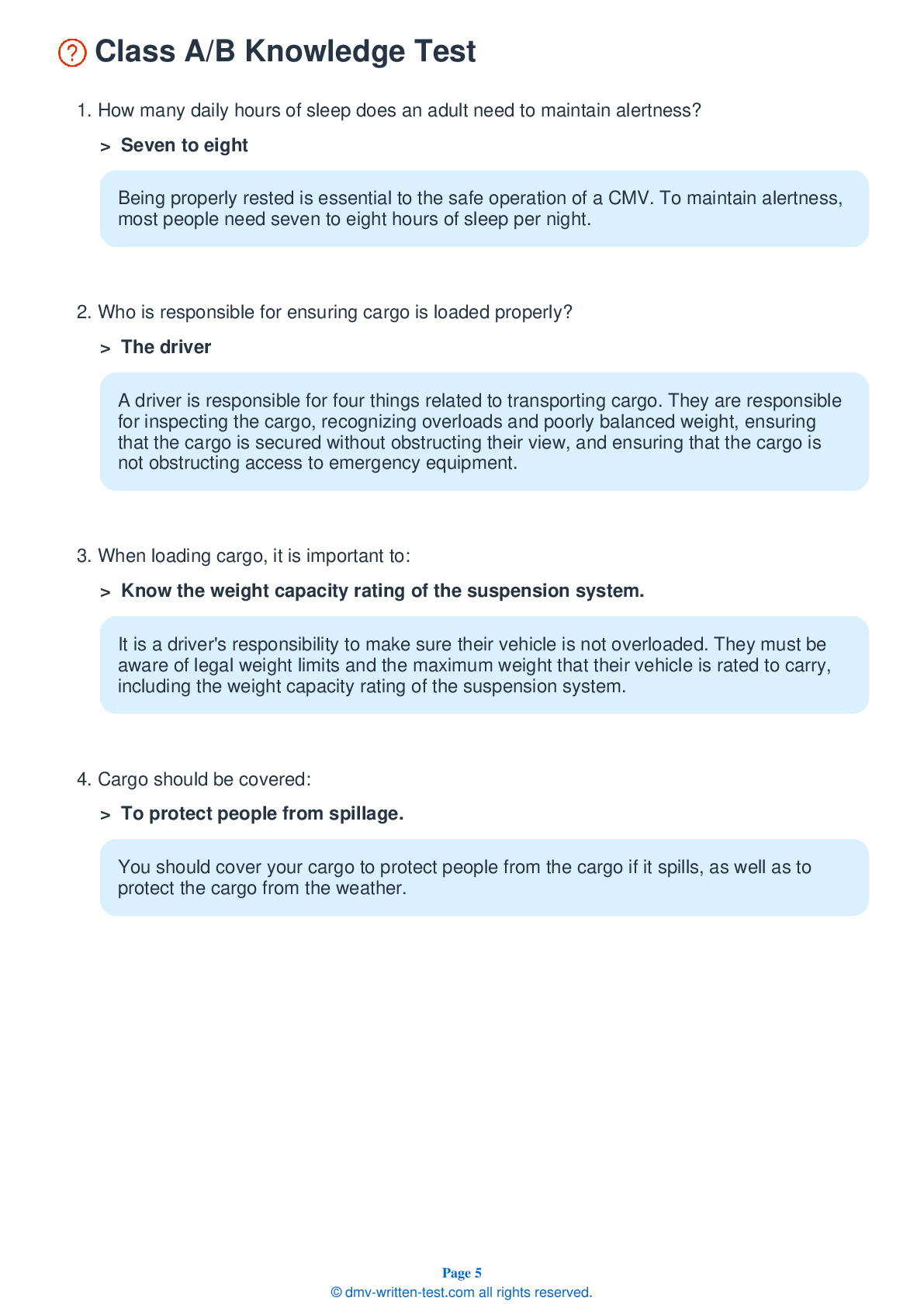Knowledge Test Class B
This license is required for driving a single vehicle with a GVWR of more than 26,001 pounds, and a trailer not to exceed 10,000 pounds gross vehicle weight rating, or a vehicle designed to transport 24 or more people (including the driver). To receive this license, applicants must pass a 50-question test. To pass, applicants must answer 40 questions correctly. Each question has three or four possible answer choices. Test questions come from the Wyoming Driver License Manual for Commercial and Heavy Vehicles. Questions come from chapters covering: Introduction, Driving Safely, Transporting Cargo Safely, Air Brakes (if applicable), Pre-Trip Vehicle Inspection Test, Basic Vehicle Control Skills Test and On-Road Driving.. Endorsements that may be used with a Class B CDL are: Hazardous materials, Tank, Passenger, HazMat and Tank, Air Brakes and School bus.
1. Without engine oil:
It is critical that an engine have sufficient oil pressure. The engine can be destroyed rapidly if run without oil.
2. A cargo van carrying a light load is usually:
The added weight of a heavy load will make a vehicle sit lower than usual. A vehicle will often be taller when carrying a light load than when carrying a heavy load. If your vehicle fits under an overpass while carrying a full load, it is not guaranteed that it will fit under the same overpass if it is empty.
3. Stopping distance can be affected by:
Factors that can affect your vehicle's stopping distance include driving speed, the vehicle's weight, and the slipperiness of the road surface.
4. When nearing a construction worker who is close to the road, you should:
When driving through work zones, you should make a particular point of reducing your speed when workers are on or near the road.
5. As part of the vehicle inspection test, a CDL applicant may be asked to:
While testing for a CDL, an applicant will be required to go through a full vehicle inspection. The vehicle inspection test will include an engine oil level check.
6. How can you prevent drowsiness before a trip?
To prevent drowsiness on a long trip, strategies include getting adequate sleep beforehand; planning out the route and stopping points in advance; driving with a passenger; and driving at times during which you are normally awake.
7. When using your mirrors, you should frequently look at your tires to:
Check your tires regularly when looking in your mirrors. This helps ensure that you will notice a tire fire, if one should happen. Tire fires may occur when a tire is under-inflated, if dual tires are touching, or if the tires are otherwise overheated.
Frequently Asked Questions
1. Obtain a Wyoming commercial learner's permit (CLP) by passing the written knowledge test for the Class B CDL.
2. Hold the CLP for at least 14 days before taking the skills test.
3. Schedule and pass the skills test, which includes a pre-trip vehicle inspection, basic vehicle control, and on-road driving.
4. Provide a valid medical examiner's certificate.
5. Pay the appropriate fees and submit an application for commercial driver's license.
6. Once issued, always carry your Class B CDL when operating a commercial vehicle.
It's important to note that there are additional endorsements that may be required to operate certain types of vehicles, such as hazardous materials or passenger transport.
1. Straight trucks: This includes delivery trucks, dump trucks, and other similar vehicles.
2. Buses: You can operate buses designed to transport more than 15 passengers, including school buses.
3. Tractor-trailers: You can operate tractor-trailers that have a trailer with a maximum weight of 10,000 pounds.
It's important to note that there may be additional endorsements required to operate certain types of vehicles, such as tankers or hazardous materials. Make sure to check with the Wyoming Department of Transportation for specific requirements and restrictions.
1. Be at least 18 years of age to operate within the state of Wyoming or 21 years old for interstate commerce.
2. Hold a valid Wyoming driver's license.
3. Pass a vision test.
4. Obtain a commercial learner's permit (CLP) by passing a written knowledge test for the Class B CDL.
5. Hold the CLP for at least 14 days before taking the skills test.
6. Schedule and pass the skills test, which includes a pre-trip vehicle inspection, basic vehicle control, and on-road driving.
7. Provide a valid medical examiner's certificate.
8. Pay the appropriate fees and submit an application for commercial driver's license.
It's important to note that there may be additional requirements for specific endorsements, such as hazardous materials or passenger transport. Make sure to check with the Wyoming Department of Transportation for specific requirements and restrictions.
It's important to note that there may be additional age requirements for specific types of vehicles or endorsements, such as hazardous materials or passenger transport. Make sure to check with the Wyoming Department of Transportation for specific requirements and restrictions.
In general, the following endorsements are available for Class B CDL drivers in Wyoming:
1. Passenger (P) endorsement: required for drivers who will be operating a vehicle designed to transport 16 or more passengers, including the driver.
2. School Bus (S) endorsement: required for drivers who will be operating a school bus.
3. Tank (N) endorsement: required for drivers who will be transporting liquids or gases in bulk containers with a capacity of 1,000 gallons or more.
4. Hazardous Materials (H) endorsement: required for drivers who will be transporting hazardous materials that require placarding.
It's important to note that additional endorsements may be required for specific types of vehicles or cargo. Make sure to check with the Wyoming Department of Transportation for specific requirements and restrictions.
1. Pre-trip Inspection: You will be required to perform a thorough inspection of your vehicle, including all safety equipment, brakes, tires, lights, and other components. You must identify any defects or problems and explain how you would correct them.
2. Basic Vehicle Control: You will be asked to demonstrate your ability to control the vehicle in various situations. This includes straight-line backing, offset backing, parallel parking, and docking.
3. On-road Driving: You will be required to demonstrate your ability to safely operate the vehicle on public roads. This includes merging onto highways, changing lanes, turning at intersections, and making emergency stops.
During the test, you will be evaluated on a variety of skills including speed control, steering control, shifting gears, signaling, and communication with other drivers. It's important to practice these skills extensively before taking the skills test.
Once you pass the skills test and other required tests (such as the written knowledge test), you will be issued a Class B CDL license which will allow you to legally operate commercial vehicles that fall under this classification in Wyoming.
1. Vehicle Weight: Drivers with a Class B CDL license are allowed to operate single vehicles with a weight rating of 26,001 pounds or more, or a combination of vehicles with a total weight rating of less than 26,001 pounds. This means that they cannot operate vehicles that exceed this weight limit.
2. Passenger Limit: Drivers with a Class B CDL license are allowed to transport up to 16 passengers (including the driver) if they have obtained the Passenger (P) endorsement on their license.
3. Cargo Limit: Drivers with a Class B CDL license are allowed to transport any type of non-hazardous material and any quantity of hazardous materials that do not require placards if they have not obtained the Hazardous Materials (H) endorsement on their license.
4. Geographic Limitation: Some states may require additional endorsements or permits for drivers with a Class B CDL license who will be operating in their state.
It's important to note that these restrictions and limitations may vary depending on the state and specific circumstances. Make sure to check with the Wyoming Department of Transportation for specific requirements and restrictions related to your Class B CDL license.
However, if you have difficulty understanding English, you may bring an interpreter with you to help translate the test questions and instructions. The interpreter must be at least 18 years old and cannot be a family member or friend. Additionally, the interpreter must sign a statement affirming that they will accurately translate the exam questions and that they will not provide any assistance beyond translation.
It's important to note that the interpreter is not allowed to assist you with answering the questions or provide any other kind of assistance beyond translation. You are solely responsible for understanding and answering the questions on your own.
If you have a disability that may affect your ability to take the test, you can request accommodations such as extra time, a separate testing room, or assistive technology. You will need to submit a written request for accommodations along with documentation of your disability and the specific accommodations you are requesting.
WYDOT will review your request and may require additional information or documentation to support your request. Once your request is approved, you will be notified of the accommodations that will be provided.
It's important to note that requests for accommodations must be made in advance, as it may take time for WYDOT to review and approve your request. Additionally, accommodations may not be granted if they fundamentally alter the nature of the test or give you an unfair advantage over other test-takers.
If you fail the written test, you will be allowed to retake it on a future date. You will need to pay the testing fee again and schedule a new appointment to take the test. You cannot retake the test on the same day.
In Wyoming, there is no limit to the number of times you can retake the written test. However, there is a waiting period of at least one day between attempts. This means that if you fail the test, you must wait at least one day before scheduling your next attempt.
It's important to note that there may be additional waiting periods or requirements if you fail the written test multiple times. For example, if you fail the test three times, you may be required to complete additional training or take a refresher course before being allowed to retake the test again.




